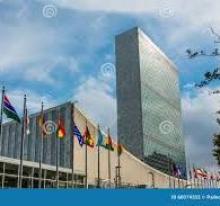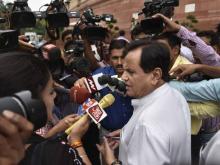
Points: 1. Which is better – Public sector or Private sector?
2. Examples, citing reasons
3. Issue of job security
4. Issue of privatisation
5. Conclusion
The old debate of the public versus the private sector – which one of the two is better for the growth of Indian economy – has been long alive. It has assumed increased importance with India’s impressive performances in the last decade in all fields: health, IT, computer software, telecommunications, generation of energy, manufacturing of industrial goods etc.

Points: 1. UN role in conflict resolution and socio-economic intervention.
2. Some of its successful actions and some of its failures.
3. Most of its failures arose in trying to enforce peace in conflicts within nations. Causes.
4. Many of its successes are on the socio-economic front
5. Impact of changes in world order on the role of UN and the need to reinvent itself.
After the first World War, many nations of the world, conscious of both their global responsibilities and the ever-looming threat of war, got together and formed League of Nations. They pledged to free mankind from the ravages of war.

Points: 1. Concern for environment has increased.
2. Pollution – a major environmental concern
3. Types and sources and effects of pollution
4. Causes and associated problems
5. Remedial measures
Both internationally and within nations, the new appreciation of our bonds with nature has spawned new institutions and policies – new UN and Governmental agencies, new laws, altered aid programmes, new international treaties. Yet for the most part, responses remain inadequate to the needs. For the most urgent need today is to protect and preserve what remains of the environment. To do that one has to understand the meaning of pollution and consider ways of tackling it.

Points: 1. Place of “opposition” in various forms of government.
2. Opposition and the party system
3. Functions of opposition in a democracy
4. During national crises, a democracy gains strength as Govt. and opposition act in concert.
5. Responsible behaviour required of opposition is to work for the nation’s good.
Although the term “opposition” was used as far back as the 18th century to refer to a party or a caucus within an assembly, the suggestion of an established opposition is relatively new. It is now quite normal to refer to a “loyal opposition” and to imply that the interests of the State are as well served by the opposition as by the government itself.

Points: 1. Concept of separation of powers in a democracy
2. Independent judiciary a must in a democracy.
3. Role of the judiciary in a democracy
4. Judicial verdicts have brought down rulers in a democracy.
5. The Indian situation
The three powers normally considered to be separable in the exercise of government in a democracy are the legislature, the executive and the judiciary. The first formulates policy and enacts it as law, the second carries out policy in action and the third applies the law according to rules of procedural justice and resolves disputes.

Points: 1. Concept of “basic structure” of the Constitution born out of judicial activism.
2. PIL and judicial activism
3. Judiciary as part of the three wings of polity; their roles & how judicial activism fits into.
4. Instances of judicial activism getting the desired results.
5. Judicial intervention inevitable when Executive & Legislative fail to perform their duties.
Judicial activism involves innovative interpretations of the nuances of law. According to Justice J. S. Verma of the Supreme Court, “The role of the judiciary in interpreting existing laws according the needs of the times and filling in the gaps appears to be the true meaning of judicial activism”.

Points: 1. Planned development not necessarily enough to control population.
2. Increase in population has diluted every achievement on development front.
3. Development has not benefited a majority.
4. How to counter the vicious syndrome?
5. Difficulties involved.
Development refers to progress in all the sectors of the economy benefitting large section of the society. In India, planned development and family planning have been going on for over five decades now.

Points: 1. Controversies in India
2. Meaning and concept
3. Why the concept has become significant?
4. Balance between development and exploitation.
5. Measures suggested.
Controversy has surrounded many major developmental and infrastructure projects in India. For example, the Sardar Sarovar dam on the river Narmada, the Chilka Lake in Orissa, the Konkan Railways, the East Coast Road etc.
Points: 1. Family – basic unit of human society, now faces eroding forces.
2. Disintegration of joint family and growth of nuclear family – causes.
3. Impact of technological and economic changes on family system.
4. Change in people’s attitude to family life – Growth of individualism & erosion of authority
5. Bright and dark sides to family
The family has for time immemorial been considered the basis of society. The idea of this institution weakening or disintegrating is so disturbing that the United Nations declared 1994 the International Year of the Family. To many of us family is the ideal unit of the human community. And yet, there are several forces eating away at its roots today.
Those who have experienced it look back nostalgically at the joint family. Not just parents, but grandparents, aunts, uncles and all the other members shared your happiness and grief and helped you grow up. The problem of looking after children hardly arose.

Points: 1. Growing population of India
2. Merits and demerits of a large population
3. Impressive GDP growth rate of India
4. Developing strategies to put the vast human resource to effective use
5. Conclusion
Population of India crossed 100 crore mark in 2011. Now, as per the estimates, our population is about 125 crores. With this huge population, we hold second position as the most populated nation in the world, next only to China. However, considering the rate at which our population is growing, within a few years, we will overtake China.
Many social scientists blame India’s overgrown population for the country’s social and economic problems. It is true that a nation’s large and growing population can hamper its progress and development. However, with proper planning, a huge population can prove to be a nation’s biggest asset as well.
